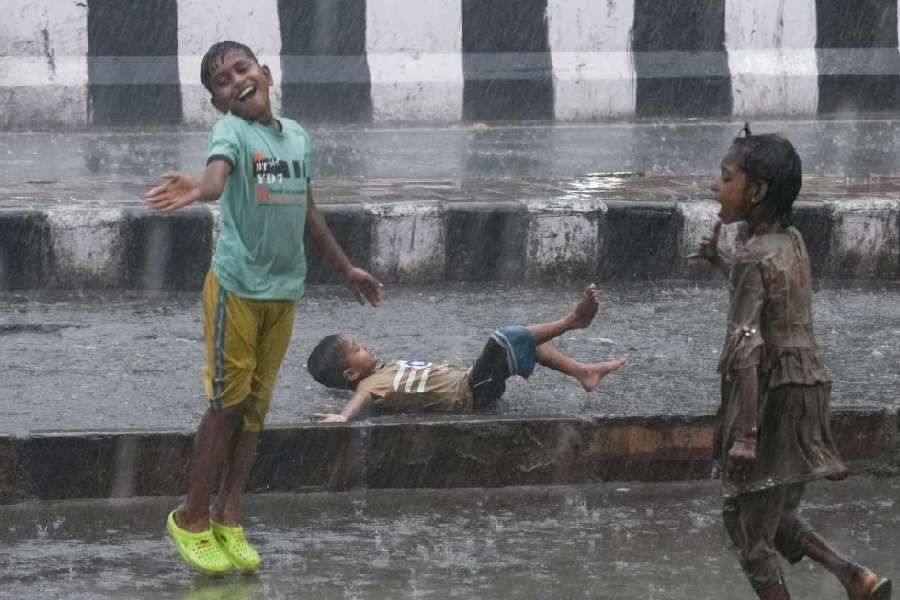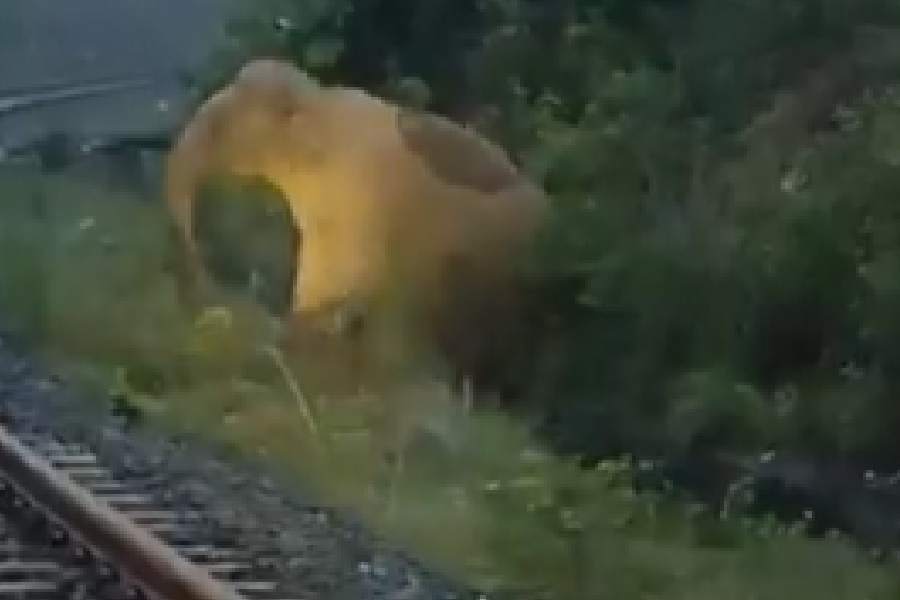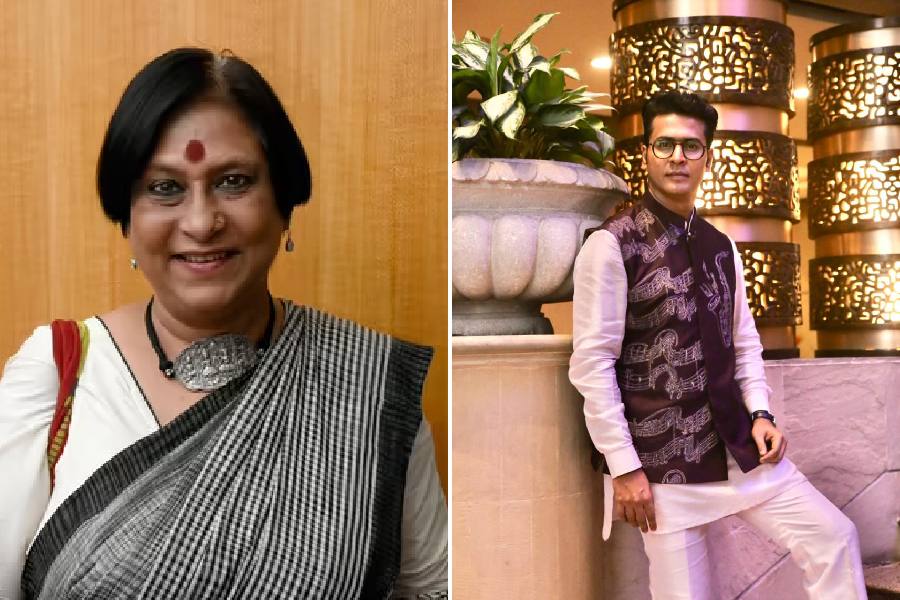 |
| Participants of the workshop preparing for the walk on Sunday morning. Picture by Amit Datta |
The wide range of skin tones that was on display inside one of the larger halls of a luxury hotel was not something that one can see in Calcutta everyday. With the warm browns and chocolates of Indians in between, at either end of the spectrum were the ivory-and-rose of the white Americans, and the deep ebony of the participant from Surinam, a woman with the gait of a queen, who wore the most colourful headgear and appliquéd textiles imaginable. The embroidery carried HIV/AIDS messages, breaking the silence around the scourge.
But hues notwithstanding, the participants were part of the global network of people who attend meetings everywhere, instantly recognisable by their tiny digital cameras whose flashes blaze on cue. They wear the same body language and they are all politically correct. The sum of their joint endeavour was the four-day workshop, titled Make Art/Stop AIDS held at the Oberoi Grand till last Sunday under the aegis of the Gere Foundation India Trust. The project director was David Gere and participants had flown in from Bangladesh, Surinam, Nepal, South Africa, the UK, and, of course, the US and several Indian states.
David Gere is an art critic, scholar and an AIDS activist whose mission is to use the arts as a weapon for fighting HIV/AIDS. Between 1980 and 1982, Gere studied and taught college in Madurai, and in the first half of this year, he stayed in Bangalore on a Fulbright research grant. A man of touching sincerity, he is also perhaps a shade too gullible. Or maybe he appears to be so.
He had visited Calcutta 20 years earlier, and recently he was given to understand that Calcutta was the place where artistes employed their gift of innovation to combat the invisible epidemic of HIV/AIDS. So he chose Calcutta as the venue of this workshop.
The problem is that HIV/AIDS has turned into this multi-billion-dollar industry and nobody wants to miss the gravy train. Allegations have been made of HIV/AIDS figures being doctored and there is a perpetual tension between non-governmental organisations working in this field and the various government units that still love to play the denial game. On the other hand, one cannot overlook the charges of inflated figures, for the higher they are the more generous is the flow of funds. As a consequence, there is every likelihood of AIDS-preventive measures being hampered.
One of the most important participants at this workshop was Suniti Solomon, director, Y.R. Gaitonde Centre for AIDS Research and Education, to whom goes the credit of documenting the first evidence of HIV infection in India in 1986. She painted a very, very grim picture of the HIV/AIDS scenario in India. Initially quoting National AIDS Control Organisation figures of 2003 she said there are 4.58 million HIV-infected people in this country, but no proper survey has been made in north India yet. She stressed that the HIV infection figures could well have touched the 10-million mark, and there are doctors in Calcutta working in related fields who would agree with her. Even more disturbing is her claim that 95 per cent of infected people don’t know they are infected.
The only hope she held out was that with the availability of anti-retroviral drugs, now being manufactured in India, even with HIV infection one could look forward to “20 years of good quality of life.” But it is an expensive proposition.
Such is the gravity of the situation that in the CBS programme 60 Minutes broadcast on April 11, the director of the CIA, which considers India a key ally in its war on terror, expressed concern at the HIV epidemic in India. However, when it comes to the CIA, Indians cannot look upon the American intelligence agency with absolute objectivity. Suniti Solomon, who has started one of the first hospitals in India for HIV/AIDS in Chennai, was the person quoted in this programme.
According to the West Bengal AIDS Prevention & Control Society, the number of AIDS cases in West Bengal between 1988 and 2003 was 2,397. Of these, 1,613 were from urban areas, and 784 from rural areas. Between 1986 and December 2003, the number of HIV-positive cases detected in Calcutta and its suburbs was 2,031, 76 in Howrah, and 408 and 421, respectively in North and South 24-Parganas. So how many times more in the entire state?
Durbar Mahila Samanwaya Committee (DMSC) has been conducting the Sonagachhi Project at 46 different points in West Bengal and Calcutta since 1992. According to point prevalence surveys in West Bengal by DMSC, the percentage of HIV-positive cases had jumped from 1.13 in 1992 to 8.5 in 2003. It was claimed that the rate of condom use among 9,000 denizens of Sonagachhi (6,000 brothel-based and 3,000 floating) has gone up from 2.7 per cent in 1992 to 84.5 per cent at present. Daily client service is three on an average. So, going by figures provided by the DMSC, 22,900 condoms are used daily in Sonagachhi alone! If that really was the case, wouldn’t the condoms have clogged the Sonagachhi sewerage system? It is difficult to separate cold fact from fiction.
Statistics alone do not strike the fear of god in us. Even three HIV positive persons present at the workshop looked perfectly well. Ramachandra Elango and Asha R, both of whom have lived with the HIV virus present in them for the past 10 years and more, are very successful at their job of keeping an advocacy programme going and helping infected people lead positive lives. Both took active part in the workshop. So did Vijay Nair from Mumbai, positive for the last nine years. He networks HIV-positive people in Maharashtra.
It was different during the great 1943 famine. That was when living skeletons cried for gruel and starving people dying by the wayside were a common sight in Calcutta. That was when artists like Somnath Hore, Zainul Abedin, Chittaprasad, Gobardhan Ash and Paritosh Sen reacted spontaneously to the man-made disaster and left behind a body of work that still hits home hard. Writers Tarashankar Bandopadhyay, Gopal Halder, Manik Bandopadhyay and Saroj Roychowdhury and photographer Sunil Janah memorably documented the situation.
Manimala and Rani Chitrakar from Midnapore were there at the workshop with their scrolls and songs. Being adaptive they have become permanent fixtures at all international fora. Children from Sonagachhi sang their piece. Little else beside from either Calcutta or Bengal.
Elsewhere, the engagement was more creative. Anurupa Roy and Varun Narain used puppets very effectively as tools of activism. The street theatre by Kamathipura Yuva Sangstha was surprisingly vibrant. So was the shadow puppetry. Celebrated photographer Sunil Gupta was the only one who raised the issue of quality in fine art.
At the end, David Gere resolved to tell the people in power in Delhi that “artists need to be full partners” in the battle. Since he holds the purse-strings, perhaps they will lend him their ear.











